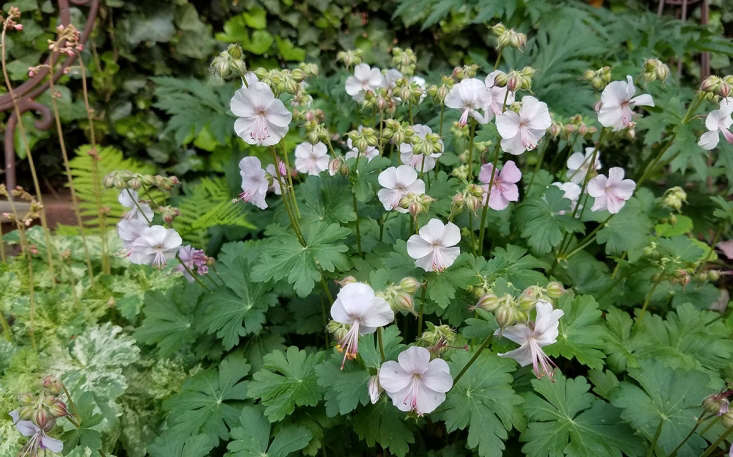Container gardening in my Brooklyn backyard is complicated; much of my north-facing garden enjoys (I use the verb with gently gritted teeth) a lot of shade.
From fall through early spring the shade is complete. The pots receive no sun at all, as it dips below a tall townhouse which casts a long shadow. But, from mid spring through late summer, the amount of welcome sunlight increases from less than one tentative hour to a solid five at the sun’s zenith, before dwindling again as the year turns.
The good news is that my garden is lush, beautifully textured, and a rainbow of green hues. Here are 12 tried-and-tested shade-loving plants that thrive in my USDA zone 7b backyard:
Photography by Marie Viljoen.

Oakleaf Hydrangea

Planted in a sturdy pot three feet tall by 20 inches wide, this dwarf cultivar stays relatively compact and is crowded with blooms from late spring. It receives the full five hours of direct sun by midsummer, but can handle less.

In two years of growing this hydrangea, I have propagated three additional shrubs. Free plants! And an excellent return on investment.

Bush Honeysuckle

The shrub is useful in water-wise gardening, as it actively dislikes being moist, and is one I frequently pass over on my daily watering rounds in summer.
Aralia ‘Sun King’

It provides substance to the back of a row of pots, and practically glows in the dark. It receives a maximum of three hours of direct sun in summer.

Ligularia

Ligularia is most famous for its enormous umbrella leaves, which add tropical drama to challenging gardens. In direct sun Ligularia leaves tend to wilt, even if well watered, but will perk up again as shade returns.
Rogersia

Generally, I err on the side of less water, as overwatered plants take time to show stress, by which time it may be hard to rehabilitate them. But these mountain natives like it wet, as long as their drainage is excellent; the water must be able to run freely from the pots’ drainage holes. (My aha moment came when I began growing wasabi this year, but that is another story.). Rogersia is also a generous giver, as it can be divided easily to make more plants. I now have three.
Lady Fern

Compared with some other ferns, the lady fern can tolerate quite dry soil, and this makes me feel less guilty about my water hogs.
Ostrich Fern

These gracefully arching fronds are one of my favorite parts of the shade garden. This plant has given rise to six additional ferns over the two years.
Hosta

I use them as specimen plants, allowing their generous sideways spread to take up as much room as they like. Mine have not been bothered by slugs, but if they are problem, fill a small dish with beer and place it in the pot for three nights (fresh beer every night, please) to catch the little marauders. Need more? Those teardrop flowers, loved by hummingbirds (and edible for humans, too).
Coral Bells



Geranium ‘Biokovo’


Jewelweed

This native annual grows prolifically in nearby damp woodlands, and one spring I carried home six seedlings. I am now never without jewelweed and have to weed dozens of volunteers out at the beginning of each growing season: its spring-loaded seed capsules explode to project seeds far from the parent. But the plants’ dramatic rise from zero to four feet tall in summer is so impressive that I never want to be without them.

Swedish Ivy

While there is no doubt that a potted garden requires more attention than one in ground (rain is not as helpful, and watering is high maintenance), it does provide benefits: containing prolific plants, and also allowing you to give custom care to plants with specific needs, from very different backgrounds; whereas in ground they share soil media and moisture, in pots you control the conditions.
Tell us about your shade: Where do you live, and what do you grow?
N.B.: For more of our favorite container gardens, see:
- Container Gardening: Sarah Raven’s 7 Tips for Perfect Flower Pots.
- A DIY Planter on Wheels.
- Boxwood: 8 Ways to Use Evergreens to Create Curb Appeal.









Have a Question or Comment About This Post?
Join the conversation